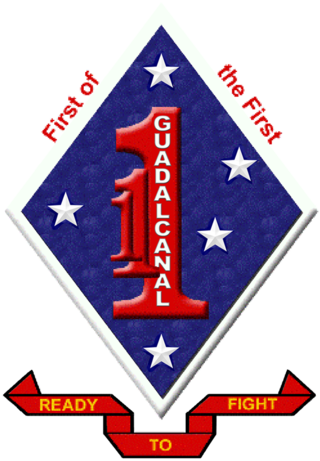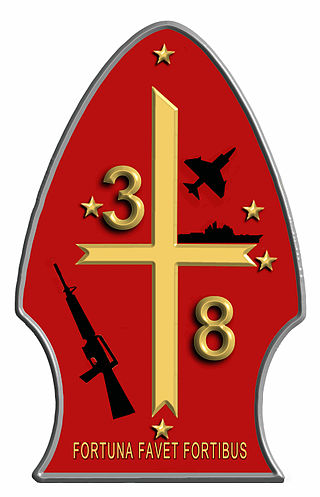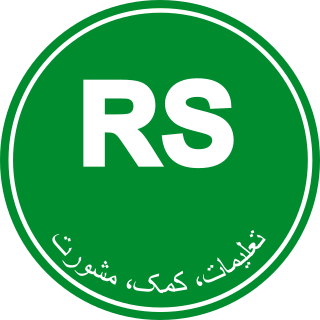
2d Battalion 5th Marines is an infantry battalion in the United States Marine Corps consisting of approximately 800 Marines and Sailors. They are based out of Marine Corps Base Camp Pendleton, California and fall under the command of the 5th Marine Regiment and the 1st Marine Division. The battalion has seen combat in World War I, World War II, the Korean War, the Vietnam War and the Gulf War and has deployed many times in support of Operation Iraqi Freedom and the current War on Terror.

1st Battalion 1st Marines is an infantry battalion in the United States Marine Corps based out of Camp Pendleton, California, consisting of anywhere from 800 to 2,000 Marines and Sailors, but the number fluctuates depending on the Battalion's mission. They fall under the command of the 1st Marine Regiment and the 1st Marine Division. Commonly referred to as "The first of the First."

3rd Battalion, 3rd Marines, abbreviated as (3/3), was an infantry battalion of the United States Marine Corps, based out of Kaneohe, Hawaii. Known as either "Trinity" or "America's Battalion", the unit normally fell under the command of the 3rd Marine Regiment of the 3rd Marine Division. When fully manned, the unit consisted of approximately 1000 U.S. Marines and United States Navy Sailors. Like most 20th century model infantry battalions of the U.S. Marine Corps, 3rd Battalion 3rd Marines was made up of three rifle companies, and a Headquarters and Services (H&S) company. The battalion was originally formed at Marine Corps Base Camp Lejeune, North Carolina in 1942 and saw action on both Bougainville and Guam during World War II, where it was awarded its first Presidential Unit Citation and Navy Unit Commendation. Marines in the battalion were also awarded one Medal of Honor and seven Navy Crosses during the war.

1st Battalion, 3rd Marines (1/3) is an infantry battalion in the United States Marine Corps based out of Marine Corps Base Hawaii. Nicknamed the "Lava Dogs", the battalion consists of approximately 800 Marines and sailors and falls under the command of the 3rd Marine Regiment of the 3rd Marine Division.

2nd Battalion, 6th Marines (2/6) is an infantry battalion in the United States Marine Corps based out of Camp Lejeune, North Carolina. Also known as "The Ready Battalion" or "2/6 Spartans", it consists of approximately 800 Marines and Sailors and falls under the command of the 6th Marine Regiment and the 2nd Marine Division.

3rd Battalion 8th Marines (3/8) was an infantry battalion in the United States Marine Corps based out of Marine Corps Base Camp Lejeune, North Carolina, was consisted of approximately 1,100 Marines and Sailors. The battalion fell under the command of the 8th Marine Regiment and the 2nd Marine Division.

The 6th Marine Regiment is an infantry regiment of the United States Marine Corps based at Marine Corps Base Camp Lejeune, North Carolina. The regiment falls under the command of the 2nd Marine Division of the II Marine Expeditionary Force. Its combat history dates back to World War I when they were part of the American Expeditionary Force. They fought in the Pacific Theater in World War II, most notably at the battles of Guadalcanal, Tarawa, Saipan, Tinian and Okinawa. More recently, the regiment has seen combat during the Gulf War and in support of Operation Iraqi Freedom.

1st Battalion, 23rd Marines (1/23) is one of 32 infantry battalions in the United States Marine Corps, and one of only eight battalions found in the reserve. It is located throughout Texas and Louisiana consisting of approximately 1000 Marines and Sailors. They fall under the command of the 23rd Marine Regiment and the 4th Marine Division.

3rd Battalion, 24th Marines (3/24) was a reserve infantry battalion in the United States Marine Corps. The battalion was first formed in 1943 for service in the Pacific Theater of Operations during World War II, taking part in a number of significant battles including those at Saipan and Iwo Jima before being deactivated at the end of the war. In the early 1960s, the unit was reactivated as a reserve battalion. It was located throughout the Midwestern United States and consisted of approximately 800 Marines and Sailors. The battalion was part of the 24th Marine Regiment and the 4th Marine Division. Recent operations included tours in Iraq and Afghanistan. On May 19, 2013, the battalion was deactivated (retired) as a part of 2013 Marine Corps Force Restructuring, along with the 24th Marine Regiment. 3/24 personnel were reallocated to 23rd Marine Regiment, with the majority of the companies becoming 3rd Battalion, 23rd Marines.

2nd Assault Amphibian Battalion is a mechanized battalion of the United States Marine Corps. Their primary weapon system is the Amphibious Assault Vehicle. The battalion is a separate battalion within the 2nd Marine Division and the II Marine Expeditionary Force. The unit is based out of the Camp Lejeune, North Carolina

Sangin is a town in Helmand province of Afghanistan, with a population of approximately 20,000 people. It is located on 32°4′24″N64°50′2″E in the valley of the Helmand River at 888 m (2,913 ft) altitude, 95 km (59 mi) to the north-east of Lashkargah. Sangin is notorious as one of the central locations of the opium trade in the south of the country, and is also a town that has traditionally supported the Taliban. It was described by British newspaper The Guardian as "the deadliest area in Afghanistan" in 2010. Sangin also houses the main bazaar for Sangin District. Route 611 passes through Sangin.

The United Kingdom was one of the first countries to take part in Operation Enduring Freedom against the Taliban regime in autumn 2001.

Nāwa-I-Barakzāyi District is an administrative district in Helmand Province, Afghanistan located south of the provincial capital of Lashkar Gah along the Helmand River. It is bordered by the districts of Lashkar Gah, Nad Ali, Garmsir, and Rig, as well as the provinces of Nimruz and Kandahar. It falls within the area known as Pashtunistan,, an area comprising most of southeast Afghanistan and northwest Pakistan. The dominant language is Pashto and many of the 89,000 residents practice the traditional code of Pashtunwali. Nawa-I-Barakzayi's name reflects the dominant Pashtun tribe in the district, the Barakzai. Prior to the 1970s, it was called Shamalan after a small village at the south end of the district
This is the Operation Herrick ground order of battle, which lists any British ground forces that have taken part in the duration of Operation Herrick between 2002 and 2014.

Camp Leatherneck was a 1,600 acre United States Marine Corps base in Helmand Province, Afghanistan. The site was mostly in Washir District and was conjoined with Camp Bastion, which was the main British military base in Afghanistan and Camp Shorabak which initially was the main Afghan section however the three sites were joined under the name of 'Camp Shorabak' in 2014.

Camp Dwyer was a military camp formerly of the United States Marine Corps located within the Helmand River Valley southwest of Garmsir in Garmsir District, Helmand Province, Afghanistan.

Forward Operating Base Delhi in Afghanistan was a military expeditionary base occupied by the United States Marine Corps. It was along the Helmand River Valley in Garmsir at an abandoned Agricultural College building.
Operation Moshtarak, also known as the Battle of Marjah, was an International Security Assistance Force (ISAF) pacification offensive in the town of Marjah, Helmand Province, Afghanistan. It involved a combined total of 15,000 Afghan, American, British, Canadian, Danish, and Estonian troops, constituting the largest joint operation of the War in Afghanistan up to that point. The purpose of the operation was to remove the Taliban from Marja, thus eliminating the last Taliban stronghold in central Helmand Province. The main target of the offensive was the town of Marjah, which had been controlled for years by the Taliban as well as drug traffickers.
Fiddler's Green was an expeditionary fire base in Afghanistan built by the United States Marine Corps. It was located off Route 605 in Nawa-I-Barakzayi District of Helmand Province. It was originally built by the 3d Battalion, 11th Marines in 2009 for Operation Strike of the Sword.

FOB Zeebrugge is a former International Security Assistance Force (ISAF) Forward Operating Base (FOB) initially operated by the British Army and the Royal Marines under Operation Herrick before being transferred to the United States Marine Corps and located in Sangin District, Helmand Province, Afghanistan.

















